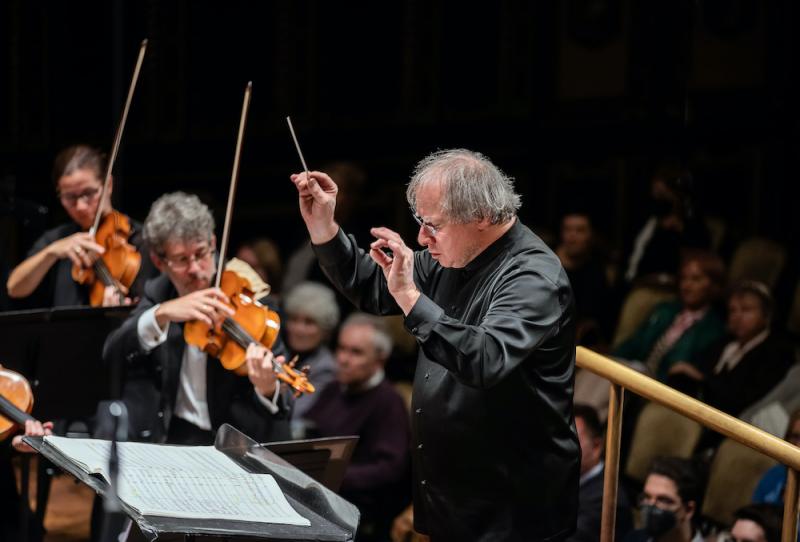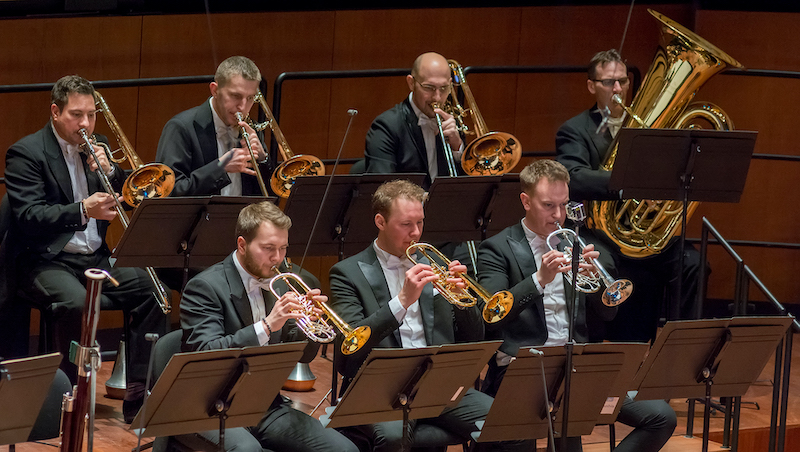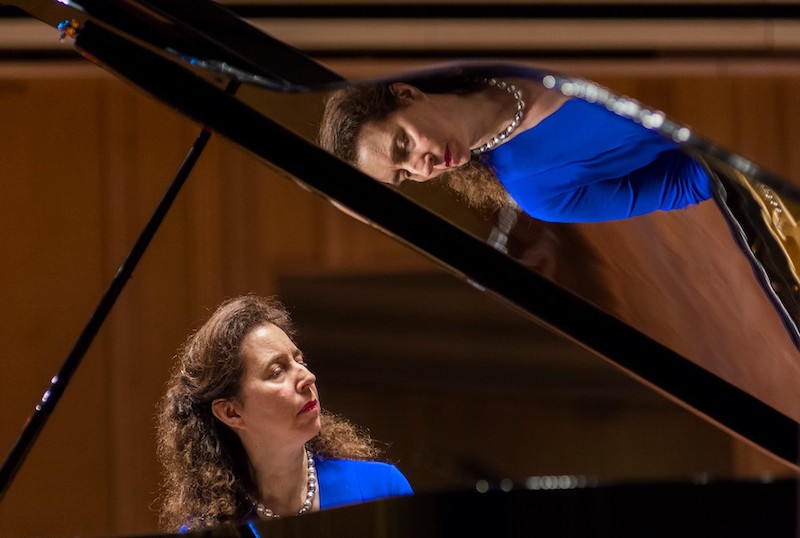Hewitt, Concerto Budapest SO, Keller, Cadogan Hall review - magical Mozart and bullish Beethoven | reviews, news & interviews
Hewitt, Concerto Budapest SO, Keller, Cadogan Hall review - magical Mozart and bullish Beethoven
Hewitt, Concerto Budapest SO, Keller, Cadogan Hall review - magical Mozart and bullish Beethoven
Smiles all round from a visiting orchestra revelling in a programme of surefire hits

Considering its status as the most famous piece of classical music [citation needed], Beethoven’s Fifth Symphony is actually quite rarely programmed in London. I can’t remember the last time I heard it live before last night, and it took the visiting Concerto Budapest Symphony Orchestra to return it to the repertoire. They played this often stern music with a smile on their faces, as they did the accompanying Mozart and Bartók.
It was, surprisingly, the Bartók – home territory for this orchestra – that struck the only uncertain note of the evening. The Concerto for Orchestra is a late masterpiece, mercurial, broad, intense and thrilling. But perhaps not the ideal opener, with its slow-burn first movement feeling a little bitty. (Surely the Beethoven is a better opener?) Things got better: the bassoon duet in the second movement sparkled, the nocturnal haziness of the third ended tantalisingly mid-thought, the fourth had satirical bite but also some sweeping string playing. Things really caught fire in the finale, its frantic energy whipped up by a flamboyant András Keller, the brass (pictured below by Andrea Felvegi) firing on all cylinders. It’s always a question with a touring orchestra: do they sound different from the British groups? Well, the string sound is different: not less polished as differently polished; the brass magnificent, the woodwind playing perhaps a touch fallible. What was noticeable was the pleasure permanently evident on the faces of the players, especially the viola front desk pairing of Lászlo Móré and Ágnes Apró, who lived every note with delight and affection.
It’s always a question with a touring orchestra: do they sound different from the British groups? Well, the string sound is different: not less polished as differently polished; the brass magnificent, the woodwind playing perhaps a touch fallible. What was noticeable was the pleasure permanently evident on the faces of the players, especially the viola front desk pairing of Lászlo Móré and Ágnes Apró, who lived every note with delight and affection.
This shared sense of fun extended to Angela Hewitt (pictured below), who joined them for Mozart’s A major Piano Concerto K. 488. She was part of the ensemble, passing lines to and from the orchestra, but there was also a marvellous robustness in her playing, and an improvisatory fluidity to the first movement cadenza. The second movement was heartbreakingly sad, Hewitt mesmerising, supported by plaintive bassoons, and the skittish finale flew by. It was a joy, as was Hewitt’s Scarlatti encore, all trills and military tattoos, the humour enjoyed but never indulged. Keller’s conducting in the Mozart was quite elaborate, making sculptures in the air with his hands, rarely deigning to simply beat time. In the Beethoven he was more straightforward and driven. The third movement featured deliciously slippery low string playing in the fugue but perhaps the best bit was the mysterious slow build-up to the finale movement, when the trombones and piccolo, the two extremes of the orchestra, are finally let off the leash. Keller drove them relentlessly to the ending – indeed, to each of the would-be endings before the actual one – and, barely pausing for breath, through the encores, including, naturally, the famous Brahms Hungarian Dance no.5.
Keller’s conducting in the Mozart was quite elaborate, making sculptures in the air with his hands, rarely deigning to simply beat time. In the Beethoven he was more straightforward and driven. The third movement featured deliciously slippery low string playing in the fugue but perhaps the best bit was the mysterious slow build-up to the finale movement, when the trombones and piccolo, the two extremes of the orchestra, are finally let off the leash. Keller drove them relentlessly to the ending – indeed, to each of the would-be endings before the actual one – and, barely pausing for breath, through the encores, including, naturally, the famous Brahms Hungarian Dance no.5.
The future of Arts Journalism
You can stop theartsdesk.com closing!
We urgently need financing to survive. Our fundraising drive has thus far raised £49,000 but we need to reach £100,000 or we will be forced to close. Please contribute here: https://gofund.me/c3f6033d
And if you can forward this information to anyone who might assist, we’d be grateful.

Subscribe to theartsdesk.com
Thank you for continuing to read our work on theartsdesk.com. For unlimited access to every article in its entirety, including our archive of more than 15,000 pieces, we're asking for £5 per month or £40 per year. We feel it's a very good deal, and hope you do too.
To take a subscription now simply click here.
And if you're looking for that extra gift for a friend or family member, why not treat them to a theartsdesk.com gift subscription?
more Classical music
 Kempf, Brno Philharmonic, Davies, Bridgewater Hall, Manchester review - European tradition meets American jazz
Bouncing Czechs enjoy their Gershwin and Brubeck alongside Janáček and Dvořák
Kempf, Brno Philharmonic, Davies, Bridgewater Hall, Manchester review - European tradition meets American jazz
Bouncing Czechs enjoy their Gershwin and Brubeck alongside Janáček and Dvořák
 Solomon, OAE, Butt, QEH review - daft Biblical whitewashing with great choruses
Even a top soprano and mezzo can’t make this Handel paean wholly convincing
Solomon, OAE, Butt, QEH review - daft Biblical whitewashing with great choruses
Even a top soprano and mezzo can’t make this Handel paean wholly convincing
 Two-Piano Gala, Kings Place review - shining constellations
London Piano Festival curators and illustrious friends entertain and enlighten
Two-Piano Gala, Kings Place review - shining constellations
London Piano Festival curators and illustrious friends entertain and enlighten
 Echo Vocal Ensemble, Latto, Union Chapel review - eclectic choral programme garlanded with dance
Beautiful singing at the heart of an imaginative and stylistically varied concert
Echo Vocal Ensemble, Latto, Union Chapel review - eclectic choral programme garlanded with dance
Beautiful singing at the heart of an imaginative and stylistically varied concert
 Scott, Irish Baroque Orchestra, Whelan, RIAM, Dublin review - towards a Mozart masterpiece
Characteristic joy and enlightenment from this team, but a valveless horn brings problems
Scott, Irish Baroque Orchestra, Whelan, RIAM, Dublin review - towards a Mozart masterpiece
Characteristic joy and enlightenment from this team, but a valveless horn brings problems
 Classical CDs: Voice flutes, flugelhorns and froth
Baroque sonatas, English orchestral music and an emotionally-charged vocal recital
Classical CDs: Voice flutes, flugelhorns and froth
Baroque sonatas, English orchestral music and an emotionally-charged vocal recital
 Kanneh-Mason, Britten Sinfonia, Shave, Milton Court - a grin and a big beaming smile
A pair of striking contemporary pieces alongside two old favourites
Kanneh-Mason, Britten Sinfonia, Shave, Milton Court - a grin and a big beaming smile
A pair of striking contemporary pieces alongside two old favourites
 theartsdesk at the New Ross Piano Festival - Finghin Collins’ musical rainbow
From revelatory Bach played with astounding maturity by a 22 year old to four-hand jazz
theartsdesk at the New Ross Piano Festival - Finghin Collins’ musical rainbow
From revelatory Bach played with astounding maturity by a 22 year old to four-hand jazz
 First Person: Manchester Camerata's Head of Artistic Planning Clara Marshall Cawley on questioning the status quo
Five days of free events with all sorts of audiences around Manchester starts tomorrow
First Person: Manchester Camerata's Head of Artistic Planning Clara Marshall Cawley on questioning the status quo
Five days of free events with all sorts of audiences around Manchester starts tomorrow
 Goldscheider, Brother Tree Sound, Kings Place review - music of hope from a young composer
Unusual combination of horn, strings and electronics makes for some intriguing listening
Goldscheider, Brother Tree Sound, Kings Place review - music of hope from a young composer
Unusual combination of horn, strings and electronics makes for some intriguing listening

Add comment